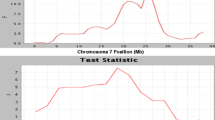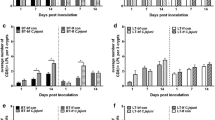Abstract
Campylobacter jejuni is the leading cause of food-borne gastro-enteritis and infection can be followed by severe clinical complications, such as the autoimmune neuropathy Guillain–Barré syndrome. Poultry meat is considered to be a common source of infection, with most flocks infected from 2 to 3 weeks of age. We have examined the effect of host genetics on the colonisation levels of C. jejuni in chickens. Chicks from different inbred lines were challenged with 107 to 108 cfu of C. jejuni 14N or C. jejuni 81–176 on the day of hatch and levels of bacterial colonisation measured over a period of 2–3 weeks. We consistently observed a 10- to 100-fold difference between four inbred lines in the number of C. jejuni organisms present in the cloaca or in the caeca, with the greatest differences detected between line N, which carried relatively high bacterial levels, and line 61, which carried relatively low numbers of bacteria. Amongst the four lines studied, major histocompatibility complex did not appear to be a major factor in determining the resistance. The difference in numbers of cloacal bacteria was observed as soon as 24 h after challenge and was still present at the end of the experiment. Lines N and 61 were chosen to analyse the mode of inheritance of the genetic differences in response to this infection. Challenge of progeny from reciprocal (N♀×61♂) and (61♀×N♂) F1 crosses and from (N♀×61♂) F1♀×N♂ backcrosses with C. jejuni 14N revealed that the difference in bacterial numbers was inherited in a manner consistent with the resistance (low bacterial numbers) controlled by a single autosomal dominant locus. These data suggest that it might be possible to identify the genes responsible by genetic mapping and candidate gene analysis.



Similar content being viewed by others
References
Acar JF, Goldstein FW (1997) Trends in bacterial resistance to fluoroquinolones. Clin Infect Dis 25:330–334
Achen M, Morishita TY, Ley EC (1998) Shedding and colonization of Campylobacter jejuni in broilers from day-of-hatch to slaughter age. Avian Dis 42:732–737
Allos BM, Blazer MJ (1995) Campylobacter and the expanding spectrum of related infections. J Clin Infect Dis 20:1092–1101
Barrow PA, Page K (2000) Inhibition of colonisation of the alimentary tract in young chickens with Campylobacter jejuni by pre-colonisation with strains of C. jejuni. FEMS Microbiol Lett 182:87–91
Barrow PA, Hassan JO, Berchieri A (1990) Reduction in fecal excretion of Salmonella typhimurium strain F98 in chickens vaccinated with live and killed Salmonella typhimurium organisms. Epidemiol Infect 104:413–426
Barrow PA, Bumstead N, Marston K, Lovell MA, Wigley P (2004) Faecal shedding and intestinal colonisation of Salmonella enterica in inbred chickens; the effect of host genetic background. Epidemiol Infect 132:117–126
Baylis CL, MacPhee S, Martin KW, Humphrey TJ, Betts RP (2000) Comparison of three enrichment media for the isolation of Campylobacter spp. from foods. J Appl Microbiol 89:884–891
Beery JT, Hugdahl MB, Doyle MP (1988) Colonization of gastrointestinal tracts of chicks by Campylobacter jejuni. Appl Environ Microbiol 54:2365–2370
Bumstead N (2003) Genetic resistance and transmission of avian bacteria and viruses. In: Muir WM (eds) Poultry genetics, breeding and biotechnology. Commonwealth Agricultural Bureau, UK
Bumstead N, Barrow PA (1988) Genetics of resistance to Salmonella typhimurium in newly hatched chicks. Br Poult Sci 29:521–529
Corry JE, Atabay HI (2001) Poultry as a source of Campylobacter and related organisms. Symp Ser Soc Appl Microbiol 30:96S–114S
Jones MA, Marston KL, Woodall CA, Maskell DJ, Linton D, Karlyshev AV, Dorrell N, Wren BW, Barrow PA (2004) Adaptation of Campylobacter jejuni NCTC11168 to a high-level colonisation of the avian gastrointestinal tract. Infect Immun 72:3769–3776
King V, Bavetsia A, Bumstead N (1993) Effect of host lineage on the virulence of Campylobacter jejuni/coli in the chick embryo model. FEMS Microbiol Lett 106:271–274
Korlath JA, Osterholm MT, Judy LA, Forfang JC, Robinson RA (1985) A point-source outbreak of campylobacteriosis associated with consumption of raw milk. J Infect Dis 152:592–596
Mariani P, Barrow PA, Cheng HH, Groenen MM, Negrini R, Bumstead N (2001) Localization to chicken chromosome 5 of as novel locus determining salmonellosis resistance. Immunogenetics 53:786–791
Mather K, Jinks JL (1971) Biometrical genetics. Chapman and Hall, London
Mead GC (2000) Prospects for ‘competitive exclusion’ treatment to control salmonellas and other foodbourne pathogens in poultry. Vet J 159:111–123
Ruiz-Palacios GM, Escamilla E, Torres N (1981) Experimental Campylobacter diarrhoea in chickens. Infect Immun 34:250–255
Shane SM (2000) Campylobacter infection of commercial poultry. Rev Sci Tech Off Int Epizoot 19:376–395
Smith HW, Tucker JF (1975) The effect of antibiotic therapy on the fecal excretion of Salmonella typhimurium by experimentally infected chickens. J Hyg 75:275–292
Smith HW, Tucker JF (1980) The virulence of Salmonella strains for chickens: their excretion by infected chickens. J Hyg 84:479–488
Stern NJ, Bailey JS, Blankenship LC, Cox NA, McHan F (1988) Colonization characteristics of Campylobacter jejuni in chick ceca. Avian Dis 32:330–334
Stern NJ, Meinersmann RJ, Cox NA, Bailey JS, Blankenship LC (1990) Influence of host lineage on cecal colonization by C. jejuni in chickens. Avian Dis 34:602–606
Acknowledgements
We are grateful to staff in the poultry units at the IAH for their care of the chickens and to the IAH for support. The later stages of this work were supported by BBSRC project grant 201/D16959.
Author information
Authors and Affiliations
Corresponding author
Rights and permissions
About this article
Cite this article
Boyd, Y., Herbert, E.G., Marston, K.L. et al. Host genes affect intestinal colonisation of newly hatched chickens by Campylobacter jejuni. Immunogenetics 57, 248–253 (2005). https://doi.org/10.1007/s00251-005-0790-6
Received:
Revised:
Published:
Issue Date:
DOI: https://doi.org/10.1007/s00251-005-0790-6




